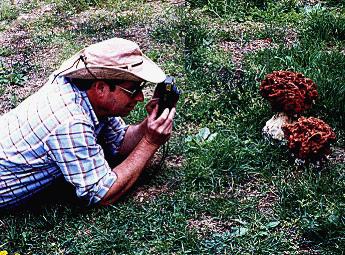That is a question of much debate. In fact, get a group of hunters together, if you can, and ask them and you are sure to start an argument. Here is a similar question left by an anonymous poster earlier today:
Anonymous said...I was under the impression that the entire morel grew underground and then 'popped up' when it could....So if you leave them they grow bigger? How much bigger? Why do you see old ones that have been up for a very long time that are still quite small, then?"Well, here is my answer the title question of this post. Yes and no. To answer Mr. or Ms, anonymous, I must explain a few things I have come to believe about morels.
First, for all my fellow Show-Me stater, Pam Kiminski, who has documented many fungi with her exceptional photography conducted a "growth study" in 2000. In her photos which can be found
here, you can clearly see the growth of the morel. I have conducted similar studies of my own with yellow morels around Mid-MO and seen similar results. But that does not mean all morels grow. There are so many variables that go into growing morels, which is one reason it took so long for mushroom growers to find a way to grow them indoors. Air and ground temps, precipitation, available nutrients in the soil and soil PH, exposure to wind and sun are just a few. With so many variables to consider, it is hard to say whether any morel will grow or not. I have left behind 5 small greys in a single patch and come back two weeks later to find 2 had become nice large yellows while 2 remained virtually unchanged and the remaining little fellow had dried up completely. So some do and some don't.
What I can tell you is that they do all start out very small and then can remain the same size until conditions are ripe for growth. I watched small greys early in the season last year take almost two weeks to grow an inch and then suddenly quadruple in size to almost 5 inches tall in only two days.
In my own experience, I believe air temperature is the major factor. In the case above the temps remained cool for the first three weeks of the season and then we had two days in which temps were between 70 and 80 degrees. This might explain why three or more days of temps above 80 mark the end to the season, as the mushrooms get large enough to fall over and begin to rot or dry up in the warmer enviroment.
I have also experienced the "popping" of morels that many hunters describe. It was in 2003 when Spring aroudn Columbia started out extremely dry with only a few sprinkles of rain for the first two weeks of April. I was out hunting around the 14th or 15th for about 3 hours thaht morning in one of my early spots thinking someting must be poking up through the leaves, yet I didn't see a dang thing. Then a storm front moved in very suddenly and it began to blow rain really hard and produce enough lightning that even a die-hard hunter like myself headed back to my vehicle for home. I caught some lunch and watched the sun come back out as the clouds retreated to the East about two hours later and headed back out to the spot I had been earlier. I was walking the trail I had walked not 2 hours earlier both in and back and what did I start seeing, morels everywhere along the trail. And not tiny teeny ones either. Some of these were 3 even 4 inches. At that moment I was convinced that morels really did just pop up. But looking back with some hindsight and more knowledge and experience, what I think happened was this.
The mushrooms were growing the whole time but were hidden, not under ground, mind you, but by the thick layer of leaves and other debris on the forest floor. It was, after all, Mid-April and even though it was dry, the area I was hunting was in the bottoms and there was sufficient moisture for morels to grow. I have found morels in this area since in very dry seasons, such as 2006, when not a drop of rain had fallen for almost three weeks.
I am sure you are wondering, so how did they pop up? Here is what I think happened. The morels had grown under the leaves to the point where the combined rain and wind from the storm front would easily exposed them giving me the impression that they had popped up in only a few hours.
Well, that's my thoughts on the matter. I am sure that there are plenty of other hunetrs out there willing to set me straight. That's waht I like most about morels and mushrooms in general. Science has done little research on them, leaving a lot of mystery and reinforcing the mushroom hunters' adage "morels grow where they want, when they want." All this speculation can be useless after all. The only real trick to mushroom hunting is being in the right place at the right time. So, heck, believe what you want, as long as you come home with a nice mess of morels who really cares. I know I don't.

 Oops sorry, I got it wrong, as CamoShroomer pointed out in his comment the second photo is what they found that afternoon. Now that's what I'm talking about.
Oops sorry, I got it wrong, as CamoShroomer pointed out in his comment the second photo is what they found that afternoon. Now that's what I'm talking about. 

.jpg)
.jpg)
.jpg)



